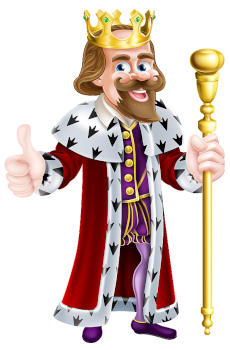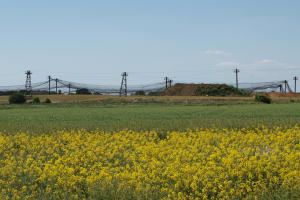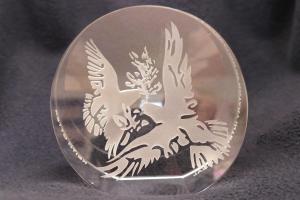Rtn Keith Otter: Legendary Kings of Britain
Thu, Sep 17th 2020 at 1:00 pm - 2:15 pm
King Lear, Old King Cole, King Arthur and others.

Our member Keith Otter told us some stories about Legendary Kings of Britain, as written down in 1136 by Geoffrey of Monmouth. These were all supposed pre-English kings and, with few exceptions, there is no evidence any of them ever existed.
According to Geoffrey, Britain was founded when a group of Trojan refugees under their leader Brutus landed in Devon. They defeated the giants who lived here then. Brutus declared himself king, named the country Britain after himself and set up his capital on the banks of the Thames at a place he called Trinovantum. This was about 950 BC.
King Lear came to the throne some 50-100 years later. The story written down by Geoffrey in 1136 is the one Shakespeare uses virtually unchanged four centuries later. In the original version, though, Lear did not go mad and Cordelia was successful in restoring him to the throne. When he died she reigned as Queen.
After her Britain descends into civil war. Around 700 BC there is a war between King Belinus and his brother Brennius, who are reconciled on the battlefield by their mother before battle can commence. They then decide to unite their two armies and invade Gaul, after which they go on to conquer Rome, making Belinus the first King of Britain to do so.
 King Lud comes to the throne somewhere around 80 BC. He has a peaceful reign, during which his efforts to improve Trinovantum turn it into the greatest city in the world and see the building of the city walls. On his death the citizens decide to rename Trinovantum in his honour - Lud’s Town, which soon becomes known as London.
King Lud comes to the throne somewhere around 80 BC. He has a peaceful reign, during which his efforts to improve Trinovantum turn it into the greatest city in the world and see the building of the city walls. On his death the citizens decide to rename Trinovantum in his honour - Lud’s Town, which soon becomes known as London.
Lud is succeeded by his brother Cassivelaunus, who definitely existed as Julius Caesar names him as the British leader who led the resistance to his invasions. According to Geoffrey of Monmouth, when Julius Caesar first invades Cassivelaunus defeats him in battle. On the second occasion Cassivelaunus destroys Caesar’s ships by putting wooden stakes in River Thames. (Caesar claims they were lost at sea.) On the third invasion Cassivelaunus is finally forced to pay tribute and Caesar returns to Rome.
Cassivelaunus’s grandson Guiderius stops paying tribute, causing the Romans under Emperor Claudius to invade. After Guiderius’s death in battle, his brother Arviragus is forced to start paying tribute again. Geoffrey never says the Romans ruled Britain, just that the Kings of Britain had to pay tribute to Rome.
The kings spend most of their time in civil wars. The crown is eventually seized by Duke Cole of Colchester, who thereby becomes Old King Cole of nursery rhyme fame (although Geoffrey doesn’t suggest he was a merry old soul).
When Cole dies the crown is seized by Constantius, who marries Cole’s daughter Helen. When he dies he is succeeded by his son Constantine who, in response to a plea for help from the Roman citizens, leads an army which conquers Rome. This makes him the second King of Britain to do - and makes him Emperor Constantine. In reality, although Constantine was in York when his troops declared him Emperor and his parents were Constantius and Helen, he was born in what is now Serbia and Helen was Greek.
In the legends Geoffrey wrote down, one of Constantine’s descendants called Maximianus becomes King of Britain and takes an army from here to conquer Rome in his turn, making him the third King of Britain to do so.
In taking an army from Britain, Maximianus removes from it all the fighting men. The Roman legions get fed up with defending Britain and leave.
Some time after the Romans depart, Vortigern makes himself King of Britain through trickery and murder. He hires Saxon mercenaries under Hengist and Horsa to help him defend the country - and gives Kent to Hengist in exchange for being allowed to marry Hengist’s daughter.
Relations between Vortigern and the Saxons deteriorate and they force him back towards what is now Wales, where he starts to build a fort. Each night whatever was built during the day falls down. Vortigern’s wise men advise him to sacrifice a boy who has no father. A countrywide search identifies such a boy, called Merlin. When he learns he is to be sacrificed, Merlin tells Vortigern to look at the fort’s foundations. The workmen discover that they are trying to build on top of two dragons.
The rightful King of Britain, Aurelius, defeats Vortigern in battle and goes on to force the Saxons back as well. He decides to build a monument to those who have died while fighting for him. Merlin goes to Ireland and brings back Stonehenge!
Aurelius is succeeded by his brother Uther Pendragon, who falls in love with Ygerna, the wife of the Duke of Cornwall. He makes war on the Duke, who sends Ygerna to Tintagel to protect her. Merlin changes Pendragon into the likeness of the Duke. In that disguise he goes to Tintagel, makes love to Ygerna and Arthur is conceived. At that point Merlin drops out of the narrative; there is no suggestion that he and Arthur ever meet.
At the age of 15 Arthur becomes King on Pendragon’s death. There is no Sword in the Stone. Wielding his trusty sword Caliburn (Excalibur in later versions of the story), Arthur finally defeats the Saxons and goes on to conquer Scotland, Ireland, Iceland, Norway and Gaul. The Orkneys surrender without a fight.
Arthur sets up his court in Caerleon (not Camelot), where it attracts distinguished men from all over Europe. As in the later legends, Arthur and his knights have a reputation for courtesy and gallantry. There is no mention of Sir Lancelot or Morgan le Fay at this stage in the development of the legend. Gawain and Mordred are named as his nephews; in the later versions of the story Mordred is described as hi son.
When Rome demands the payment of tribute, King Arthur and his knights go to the continent and Arthur becomes the fourth King of Britain to conquer the city.
On his return, Arthur discovers his Queen Guinevere is now living with his nephew Mordred. (In the later legends she commits adultery with Sir Lancelot.) He defeats Mordred in battle but is himself mortally wounded. He is taken to the Isle of Avalon, where his wounds can be healed and where he can rest until needed to defend Britain again.
As Keith pointed out, Arthur’s return won’t do the English much good. When he comes again it will be to defend the descendants of the Britons he knew, who were long ago forced back into Wales. The English are the descendants of his enemies, the Saxons!
'What We Do' Main Pages:










